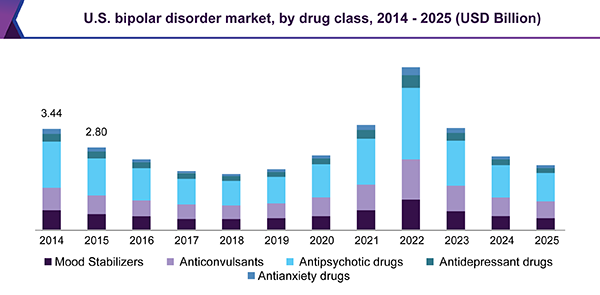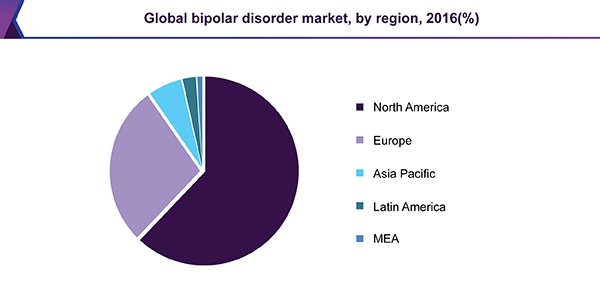- Home
- »
- Pharmaceuticals
- »
-
Bipolar Disorder Market Size & Share Report, 2018-2025GVR Report cover
![Bipolar Disorder Market Report]()
Bipolar Disorder Market Analysis By Drug Class (Mood stabilizer, Anticonvulsant, Antipsychotic, Antidepressant, Antianxiety), By Mechanism of Action, By Region, And Segment Forecasts, 2018 - 2025
- Report ID: GVR-2-68038-033-0
- Number of Report Pages: 95
- Format: PDF, Horizon Databook
- Historical Range: 2014 - 2016
- Forecast Period: 2017 - 2025
- Industry: Healthcare
Report Overview
The global bipolar disorder market size was valued at USD 4.9 billion in 2016 and is expected to grow at a CAGR of 2.10% during the forecast period. Increasing prevalence of bipolar disorder, government support for generating awareness about the bipolar disorder, and technological advancements that facilitate accurate detection of a patient’s mood and mental state are a few of the factors driving the growth of this market. For instance, the use of tricyclic antidepressants has declined over the years owing to the higher incidence of side effects in comparison to other drugs used for the treatment of bipolar disorder.

Besides, governments of several nations are allocating funds for research in the field of bipolar disorder and initiating awareness campaigns to eliminate the stigma associated with bipolar disorder and improve treatment and adherence rates amongst the general population. Scientific bodies and medical institutions are also playing an active role by conducting research studies and developing novel drugs and treatments for bipolar disorder. For instance, the Salk Institute for Biological Studies and the Johns Hopkins University of Medicine launched an initiative in 2016 worth USD 15.4 million in order to develop new studies and drug screening methods for bipolar disorder and schizophrenia.
Advancement in technology is further aiding the market growth, as the use of smartphones, smartwatches, and wearable devices facilitates accurate detection of a patient’s mood and mental state and also captures physiological, behavioral, and environmental data effectively. Besides the advent of online self-management tools for mental disorders enables timely intervention and better adherence to prescribed treatment.
However, many of the drugs used in the treatment of bipolar disorder have associated side effects which include addiction of the body to the drug, diabetes and cholesterol issues, blurred vision, damage to the liver, and thyroid, among others. Studies have also linked a few of the drugs to severe side effects such as causing renal failure and teratogenic changes in the fetus if used by pregnant women. Further, a large number of times bipolar disorder may be misdiagnosed as depression or personality disorder which may also lower the diagnosis and treatment rates of this mental disorder.
The patent expiry of blockbuster drugs in this market may also have a significant impact on the market dynamics. The drugs in the bipolar disorder market face intense competition due to the foray of generic drugs as treatment options for bipolar disorder. For instance, patent expiration of blockbuster drugs such as Seroquel, Zyprexa, Risperdal, and Invega are likely to restrain market growth owing to the increasing generic substitutes in the market.
Drug Class Insights
The drug classes analyzed in this study include mood stabilizers, anticonvulsants, antipsychotic drugs, antidepressant drugs, and antianxiety drugs. The antipsychotic drug segment dominates the market. It is used with SSRI as part of a combination therapy and has demonstrated good results thereby causing more number of physicians to opt for these medications.
Anticonvulsants serve as effective depression mood stabilizer by alleviating the depressive symptoms of bipolar disorder without precipitating mania. These drugs overcome the limitations faced by traditional antidepressants as they stabilize the mood without triggering mania or causing episode acceleration. The extensive use of anticonvulsants, as a single drug or as a part of combination therapies, will quickly drive the growth of the market segment over the forecast period.
Mechanism of Action Insights
Various segments based on the mechanism of action of the drugs analyzed in this study include selective serotonin reuptake inhibitors, serotonin norepinephrine reuptake inhibitors, tricyclic antidepressants, monoamine oxidase inhibitors, benzodiazepines, beta blockers, and others.
Selective serotonin reuptake inhibitor segment is anticipated to dominate the market initially but, over the forecast period serotonin norepinephrine reuptake inhibitors have gained market share
Benzodiazepines are generally not prescribed as the primary treatment for bipolar disorder. However, they may be prescribed in combination with other drugs to control certain manic symptoms such as restlessness, agitation, and insomnia until mood-stabilizing drugs take effect.

Regional Insights
North America held approximately 61.3% share in the market in 2016, owing to rising prevalence of bipolar disorder in North America. This can be attributed to the high-stress levels, insufficient sleep, and trend of substance abuse amongst the population. In addition, government initiatives for creating awareness and supporting patients with bipolar disorder is also expected to fuel market growth in this region. For instance, the Substance Abuse and Mental Health Services Administration’s (SAMHSA) Center for Mental Health Services (CMHS), which is a branch of the U.S. Department of Health and Human Services, has expanded its support for mental health treatment and recovery in 2016. Such initiatives are likely to boost the growth of this regional segment in the forecast period.
Asia Pacific is expected to register higher CAGR over the forecast period as compared to other regions, which can be attributed to the high prevalence of mental disorders in this region. According to data published by WHO, India and China rank amongst the countries most affected by mental disorders such as anxieties, schizophrenia, and bipolar disorder. Besides government initiatives such as the Healthy Asia Pacific 2020 initiative, launched in 2014 by Asia Pacific Economic Cooperation (APEC) body are likely to propel the market in this region.
Competitive Outlook
Some of the major players in this space include Glaxo SmithKline (GSK), Pfizer Inc., Janssen Pharmaceuticals, Eli Lilly, Allergan Plc., Novartis AG, AbbVie Inc., Otsuka Holdings Co. Ltd, and AstraZeneca.
These players focus on growth strategies, such as drug development, approvals, acquisitions, and expansions. For instance, in March 2016, Allergan Plc.announced the availability of Vraylar in the U.S. for bipolar disorder treatment. Further, in March 2017, FDA accepted Supplemental New Drug Application by Allergan for Vraylar.
Bipolar Disorder Market Report Scope
Report Attribute
Details
Market size value in 2020
USD 5.4 billion
Revenue forecast in 2025
USD 4.9 billion
Growth Rate
CAGR of 2.1% from 2017 to 2025
Base year for estimation
2016
Historical data
2014 - 2016
Forecast period
2017 - 2025
Quantitative units
Revenue in USD million and CAGR from 2017 to 2025
Report coverage
Revenue forecast, company share, competitive landscape, growth factors and trends
Segments covered
Drug class, mechanism of action, region
Regional scope
North America; Europe; Asia Pacific; Latin America; MEA
Country scope
U.S.; Canada; UK; Germany; France; Japan; China; Brazil; Mexico; South Africa
Key companies profiled
Glaxo SmithKline (GSK); Pfizer Inc.; Janssen Pharmaceuticals; Eli Lilly; Allergan Plc.; Novartis AG; AbbVie Inc.; Otsuka Holdings Co. Ltd; AstraZeneca
Customization scope
Free report customization (equivalent up to 8 analysts working days) with purchase. Addition or alteration to country, regional & segment scope.
Pricing and purchase options
Avail customized purchase options to meet your exact research needs. Explore purchase options
Segments Covered in the ReportThis report forecasts revenue growth and provides an analysis on the latest trends in each of the sub-segments from 2014 to 2025. For the purpose of this study, Grand View Research, Inc. has segmented the bipolar disorder market on the basis of drug class, mechanism of action, and region:
-
Drug Class Outlook (Revenue, USD Million, 2014 - 2025)
-
Mood Stabilizers
-
Anticonvulsants
-
Antipsychotic drugs
-
Antidepressant drugs
-
Antianxiety drugs
-
-
Mechanism of Action Outlook (Revenue, USD Million, 2014 - 2025)
-
Selective Serotonin Reuptake Inhibitor
-
Serotonin Norepinephrine Reuptake Inhibitors
-
Tricyclic Antidepressants
-
Monoamine Oxidase Inhibitors
-
Benzodiazepines
-
Beta Blockers
-
-
Regional Outlook (Revenue, USD Million, 2014 - 2025)
-
North America
-
U.S.
-
Canada
-
-
Europe
-
Germany
-
UK
-
-
Asia Pacific
-
Japan
-
China
-
-
Latin America
-
Brazil
-
Mexico
-
-
Middle East and Africa (MEA)
-
South Africa
-
Saudi Arabia
-
-
Frequently Asked Questions About This Report
b. The global bipolar disorder market size was estimated at USD 4.4 billion in 2019 and is expected to reach USD 5.4 billion in 2020.
b. The global bipolar disorder market is expected to grow at a compound annual growth rate of 2.1% from 2017 to 2025 to reach USD 4.9 billion by 2025.
b. North America dominated the bipolar disorder market with a share of 60.14% in 2019. This is attributable to high-stress levels, disturbed sleep, and the trend of substance abuse amongst the population.
b. Some of the key players operating in the bipolar disorder market include Glaxo SmithKline (GSK), Pfizer Inc., Janssen Pharmaceuticals, Eli Lilly, Allergan Plc., Novartis AG, AbbVie Inc., Otsuka Holdings Co. Ltd, and AstraZeneca.
b. Key factors that are driving the market growth include increasing prevalence of bipolar disorder and increasing government support.
Share this report with your colleague or friend.
![gvr icn]()
NEED A CUSTOM REPORT?
We can customize every report - free of charge - including purchasing stand-alone sections or country-level reports, as well as offer affordable discounts for start-ups & universities. Contact us now
![Certified Icon]()
We are GDPR and CCPA compliant! Your transaction & personal information is safe and secure. For more details, please read our privacy policy.
We are committed towards customer satisfaction, and quality service.
"The quality of research they have done for us has been excellent."





